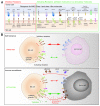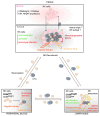NK cells sense tumors, course of disease and treatments: Consequences for NK-based therapies
- PMID: 22720210
- PMCID: PMC3376977
- DOI: 10.4161/onci.1.1.18312
NK cells sense tumors, course of disease and treatments: Consequences for NK-based therapies
Abstract
The recent findings on NK activation indicate that these cells are important antitumor effectors. NK cells participate in the graft-vs.-leukemia effect to control the relapse in leukemic patients transplanted with allogeneic hematopoietic stem cells. In various tumors, correlation between NK cell infiltrates and prognosis were reported. However, tumor-infiltrating NK cells are yet poorly characterized. We here summarize our results and the recent studies of the literature on tumor-infiltrating NK cells, and discuss the impact of these novel insights into NK cell responses against tumors for the design of NK cell-based therapies.
Figures



References
Publication types
LinkOut - more resources
Full Text Sources
